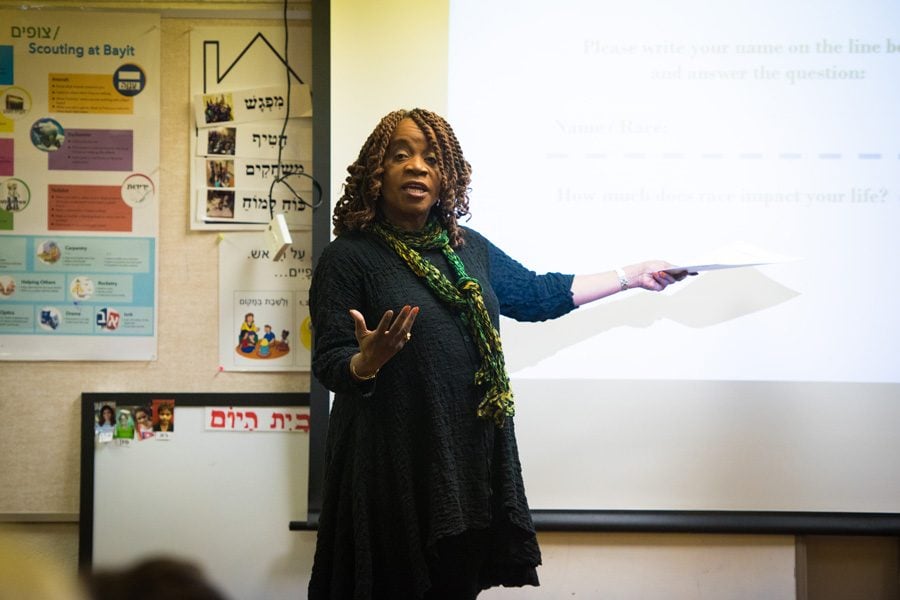Evanston Township High School/District 202 board president speaks on race in education
Daniel Tian/Daily Senior Staffer
ETHS/D202 Board President Pat Savage-Williams speaks Tuesday night at an event hosted by the Organization for Positive Action and Leadership of Evanston. Savage-Williams talked about racial disparities in the education system and her own experiences at ETHS.
April 13, 2016
The board president of Evanston Township High School/District 202 emphasized the difference between racial consciousness and racial impact in education during a community dialogue Tuesday night.
This past weekend, ETHS/District 202 Board President Pat Savage-Williams said she was in Boston receiving a Magna Award from the National School Boards Association for the district’s equity work. On Monday night, she was a part of a conversation discussing ongoing racial inequities at ETHS during a school board meeting.
Savage-Williams said the contrast between the two events reflects the work the district has done and how far it has to go.
“‘How come we’re still having this conversation?’” Savage-Williams said. “This is why, and this is what, the Magna Award is about.”
Roughly 20 people attended the event at the Unitarian Church of Evanston, 1330 Ridge Ave., which was hosted by the Organization for Positive Action and Leadership of Evanston.
The discussion focused on racial equity versus equality in Evanston’s education system — although Savage-Williams said these disparities exist in all societal spheres. She said there is a difference between treating everyone the same and treating everyone fairly, encouraging participants to reflect upon their own experience with race as part of the workshop.
“The racial impact, we all have it, because it’s like the ground we walk on,” Savage-Williams said. “It’s always there and there’s nothing we can do. We’ve got to walk somewhere.”
Citing data from ETHS, Savage-Williams said the number of Latino and black graduates who had taken at least one AP course had increased by roughly 15 percentage points from 2012 to 2014. But while the rate of black students who took at least one AP course hit 50.5 percent in 2014, the same rate for white student was 89.5 percent in the same year, according to the district’s 2014-2015 Report on Student Achievement. The rate of Latino students who took at least one AP course in 2014 was 67.6 percent.
Martha Burns, a retired ETHS board member and a member of OPAL, said she was frustrated with the way race and education are discussed in the community.
“White people in this room… it would be wonderful to see you at the mic saying that this is not right,” Burns said. “And as a black person sitting in a black body, it also frustrates me from my standpoint that black people have a tendency to say, ‘Oh, that’s not my kid,’ if we’re considered middle class or upper middle class.”
Other topics of discussion included the comparison of testing scores between Latino and black students, the placement of Evanston’s best teachers and the tenure process.
OPAL President Cicely Fleming said a big focus for the organization is working to create action toward racial equity within District 65, adding that while there’s still work to be done at ETHS, District 202 has done more to address these issues.
“[ETHS] still has a ways to go — they have made some success — but when we look at District 65, which is our K-8 schools, we are really far behind,” Fleming said.
Fleming added that OPAL regularly hosts meetings to create a community dialogue.
“We want people to be educated — but then be empowered to take the next step and take action,” Fleming told The Daily.
OPAL will continue to host meetings through the end of the school year and then transition to a focus on community organizing through the summer, Fleming said.
Savage-Williams said she often receives questions about why she hosts workshops similar to OPAL’s at majority-white high schools such as nearby New Trier High School in Winnetka, where she works.
“I’m not doing it for the black and brown kids,” Savage-Williams said. “They got it. They know it. I’m doing it for all the other kids.”
Correction: A previous version of this story misstated the percent increase of Latino and black graduates who had taken at least one AP course. It increased by 15 percentage points. The Daily regrets the error.
Email: darbyhopper@u.northwestern.edu
Twitter: @darby_hopper


